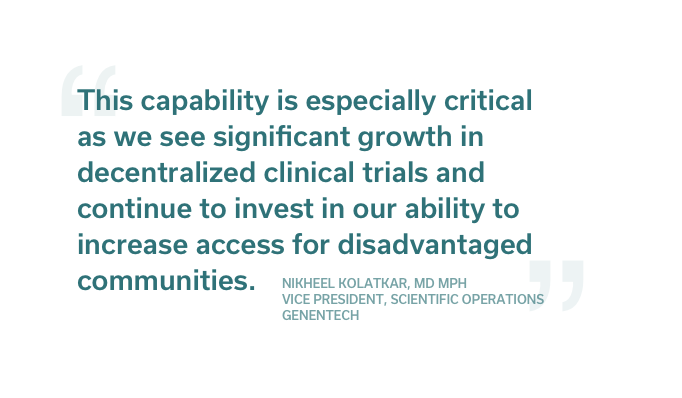There’s no question about it: modern medicine is more advanced and more tailored to patients than ever. The pharmaceutical industry is innovating faster than ever before, producing thousands of life-saving drugs.
However, this rapid pace of innovation also means that today’s clinical trial landscape is orders of magnitude more complex than it was 10 years ago. The number of registered clinical trials has skyrocketed 150x since 2000, and the average number of outcomes measured per trial has increased 86% over the last 20 years.
This explosion has put enormous pressure on the scarcest resource: patients. Recruitment accounts for 30% of the clinical trial timeline, and trial participation has not tracked with increased demand.
Identifying, screening, and enrolling patients is now the single largest research bottleneck.
86% of clinical trials are delayed 1-6 months because they can’t meet their recruitment targets on time. 15-20% of trials never even enroll a single patient and are forced to close. Delays have severe clinical and financial implications — prolonging time to market deprives patients of access to treatments, and costs pharmaceutical companies $500,000+ per day of delay.
Three Things Holding Back Trial Recruitment

Poor Patient and Physician Awareness About Clinical Trials
Imagine you’re a patient suffering from liver cancer, and the conventional treatment options prescribed by your doctor aren’t working. Frustrated, you continue with your current treatment plan because you think you have no alternative, until someone suggests you enter into a clinical trial for an experimental drug treatment.
 Lack of Patient Education About Clinical Trial Risks and Benefits
Lack of Patient Education About Clinical Trial Risks and Benefits
You decide to consider enrolling in a clinical trial for your condition but aren’t sure about the risks. You’re not alone; over 40% of patients report feeling concerned about the risks associated with clinical trials, and 21% report they are not willing to enroll in a clinical trial because they do not have enough knowledge about the clinical research being performed.
 Readability and Comprehension of Trial Information
Readability and Comprehension of Trial Information
You finally decide to enroll in the clinical trial, but you’re not exactly sure what you’re committing to. The informed consent you are handed contains lots of medical jargon and acronyms and is difficult to understand. The average consent form is written at the 10th grade reading level, while the American Medical Association and National Institutes of Health recommend that patient materials be written at a 6th grade level. Poor comprehension can have disastrous downstream consequences — patients who drop out of trials early are twice as likely to report difficulty understanding the informed consent form than patients who complete trials.
How Conversational Technology Can Improve Trial Recruitment and Enrollment
Clinical trials have historically been broken out into two separate, siloed activities. First, patients are identified and recruited for a trial. Then, trial enrollment and downstream engagement are managed by a separate set of individuals (typically at the site level). This disjointed handoff process between recruitment and enrollment represents one of the largest improvement opportunities.
Each individual patient must be called multiple times in order to be both screened and enrolled. Patients that are not called within 48 hours are also significantly more likely to lose interest in the trial, meaning that site staff have a very small window to engage patients and get them enrolled in the trial.
Compare this inefficient, ineffective method to the easily automatable conversational technology available today. Chatbots can engage patients immediately on their mobile devices and turn screening and enrollment workflows into conversations. And instead of having to play phone tag with patients, chatbots can have concurrent conversations with patients at times that work best for them.
It’s time to focus on building patient motivation and trust before the study even starts by streamlining trial recruitment. Digital patient engagement, delivered as highly intuitive and approachable chatbots, can wrap the existing trial recruitment process.
Leveraging conversational technology can boost enrollment numbers and patient satisfaction — all before the patient shows up for the first site visit.
Chatbots that understand trial eligibility requirements and protocols can answer questions, mitigate fear, and establish a constant thread of communication with patients. Informed consent processes can be turned into conversations, which help improve comprehension and increase the likelihood that the patient will stay informed and engaged during the study. Patient concerns can be directly alleviated during these conversations as well, without requiring additional lift by clinical staff.
Technology can also reduce research coordination lift and improve responsiveness. Chatbots can determine patient eligibility and conduct pre-screening without human involvement, and pass patients to research coordinators only after they are qualified.
A single chatbot deployed across hundreds of online outposts can simultaneously handle a clinical trial advertising campaign, provide interested patients information regarding the trial, and walk patients step-by-step through the trial itself, offloading thousands of hours of effort from research staff.
Conversational technology allows trials to hold thousands of concurrent conversations, gathering important patient data and giving patients a consistent, high-touch clinical trial experience. The entire clinical trial recruitment process can be compressed and efficient, allowing clinical staff to direct their attention to the treatment portion of the trial. The result will be faster trials, happier patients, and more accurate data — very easily a worthwhile investment.








